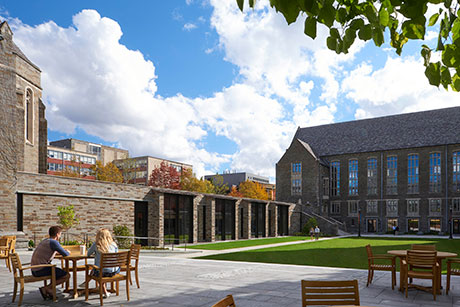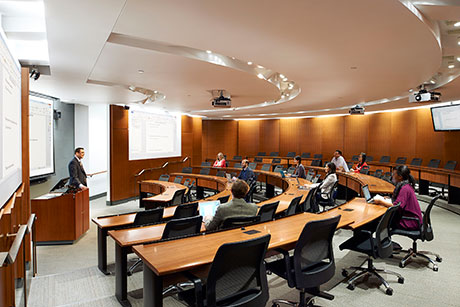Law school addition certified platinum by green building group
By Blaine Friedlander

The newly constructed addition to the Cornell Law School’s Myron Taylor Hall exceeded its sustainable burden of proof, leaving no reasonable doubt that it’s now certified LEED (Leadership in Energy and Environmental Design) Platinum – the highest level accreditation possible – by the U.S. Green Building Council.
By building the new addition underground, architects were able to utilize the portion of Myron Taylor Hall with a vegetated green roof, which provides thermal benefits and boosts energy efficiency, according to Matthew Kozlowski, the green building program manager in Cornell’s Facilities Services.
Designed by Scott B. Aquilina (AIA) of Ann Beha Architects, the new academic space features three-tiered classrooms, breakout space, a renovated lobby and a café for students and faculty.Mike Husar, an architect, served as Cornell’s senior project manager.
“The thermal performance of the building is extraordinary,” said Kozlowski. The building’s energy performance was optimized with state-of-the-art heating, ventilation and air conditioning, and automated building control systems. The energy saving is about 64 percent, the highest-performing modeled building on campus to date, he says.

Project designers strove to incorporate recycled content and regionally manufactured materials into the building and furnishings. Kozlowski explained this includes extensive use of locally quarried stone in the courtyard. About 20 percent of the building material is recycled content and about 21 percent of the material value in the building is regionally manufactured and extracted.
During construction, contractors recycled and reused waste materials, and diverted more than 90 percent of the waste material from landfill, Kozlowski said. All paints, adhesives, sealants, flooring and wood products, and furnishings meet strict volatile organic compound limits to reduce indoor air pollution and promote a healthy environment, he said.
Carbon dioxide sensors were installed in the teaching areas, so when the classrooms are occupied, the area receives fresh air. The system saves energy by shutting down when the room is unoccupied.
The law school addition is the second LEED Platinum certification for the university. The Human Ecology Building was certified Platinum and completed in fall 2011. This project marks the 15th LEED certified project on campus.
Media Contact
Get Cornell news delivered right to your inbox.
Subscribe